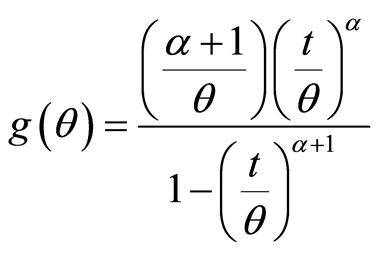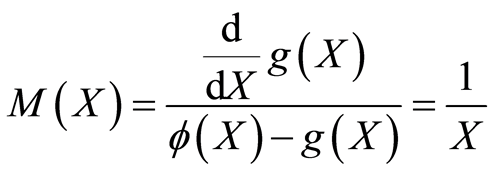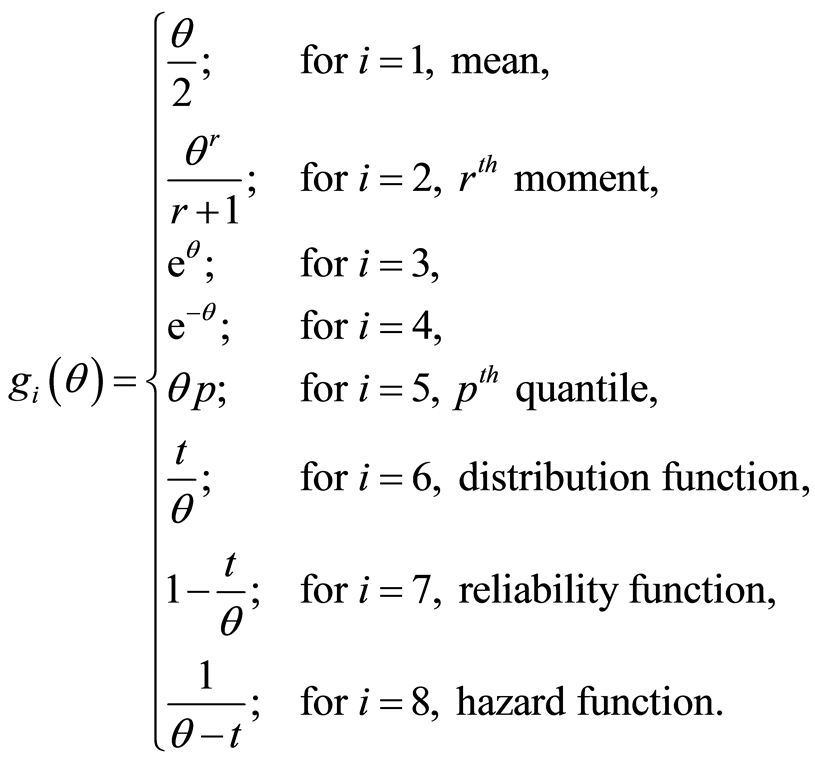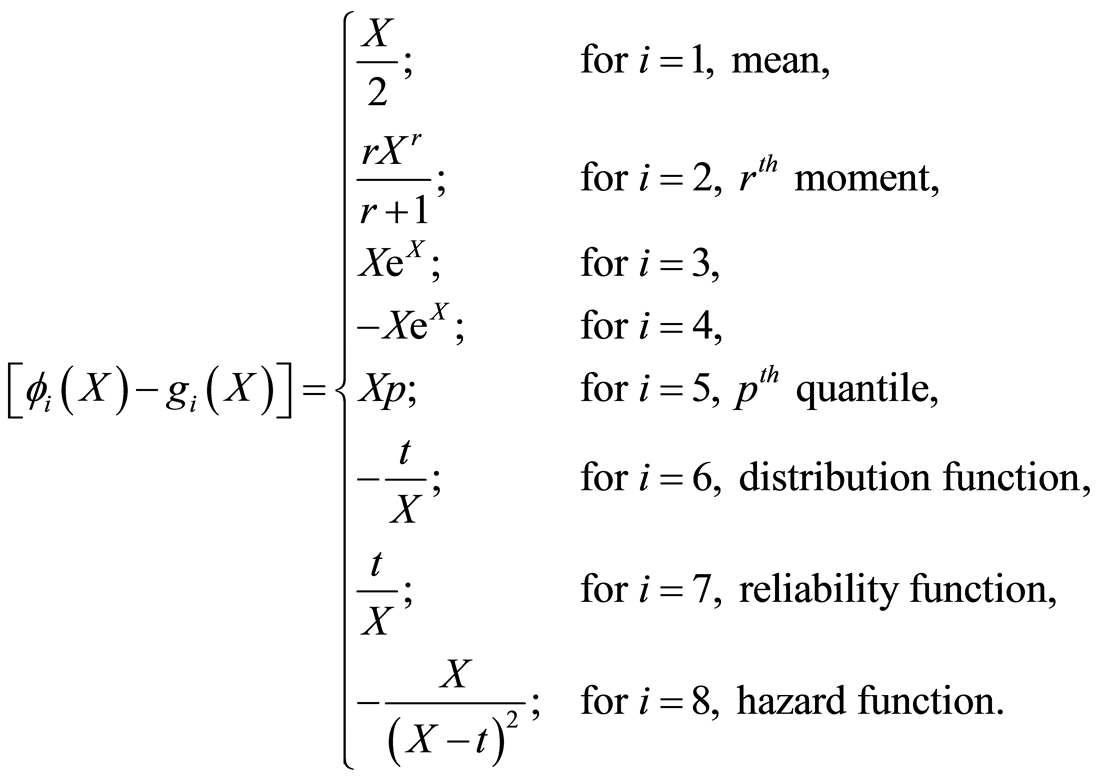Characterization of Generalized Uniform Distribution through Expectation ()
1. Introduction
Normally the mass of a root has a uniform distribution. Plant develops into the reproductive phase of growth; a mat of smaller roots grows near the surface to a depth of approximately 1/6-th of maximum depth achieve (see G. Ooms and K. L. Moore [1] ). Dixit [2] studied the problem of efficient estimation of parameters of a uniform distribution in the presence of outliers. He assumed that a set of random variables  represents the masses of roots where out of n-random variables some of these roots (say k) have different masses; therefore, those masses have different uniform distributions with unknown parameters and these k observations are distributed with Generalize Uniform Distribution (GUD) with probability density function (pdf)
represents the masses of roots where out of n-random variables some of these roots (say k) have different masses; therefore, those masses have different uniform distributions with unknown parameters and these k observations are distributed with Generalize Uniform Distribution (GUD) with probability density function (pdf)
 (1.1)
(1.1)
where  are known constants;
are known constants;  is positive absolutely continuous function and
is positive absolutely continuous function and  is everywhere differentiable function. Since derivative of
is everywhere differentiable function. Since derivative of  being positive, range is truncated by
being positive, range is truncated by  from right
from right .
.
Dixt [3] obtained Maximum Likelihood Estimator (MLE) and the Uniformly Minimum Variance (UMVU) estimator of reliability functional,  in the same setup and showed that the UMVUE is better than MLE when one parameter of GUD is known, where as both parameters of the GUD are unknown,
in the same setup and showed that the UMVUE is better than MLE when one parameter of GUD is known, where as both parameters of the GUD are unknown,  is estimated by using mixture estimate and is consistent.
is estimated by using mixture estimate and is consistent.
In this paper the problem of characterization of GUD with pdf given in (1.1) has been studied and the characterization also holds for uniform distribution on interval  when
when . Various approaches were used to characterize uniform distribution; few of them have used coefficient of correlation of smaller and the larger of a random sample of size two; Bartoszyn’ski [4] , Terreel [5] , Lopez-Bldzquez [6] as Kent [7] , have used independence of sample mean and variance; Lin [8] , Too [9] , Arnold [10] , Driscoll [11] , Shimizu [12] , and Abdelhamid [13] have used moment conditions, n-fold convolution modulo one and inequalities of Chernoff-type were also used (see Chow [14] and Sumrita [15] ).
. Various approaches were used to characterize uniform distribution; few of them have used coefficient of correlation of smaller and the larger of a random sample of size two; Bartoszyn’ski [4] , Terreel [5] , Lopez-Bldzquez [6] as Kent [7] , have used independence of sample mean and variance; Lin [8] , Too [9] , Arnold [10] , Driscoll [11] , Shimizu [12] , and Abdelhamid [13] have used moment conditions, n-fold convolution modulo one and inequalities of Chernoff-type were also used (see Chow [14] and Sumrita [15] ).
In contrast to all above brief research background and application of characterization of member of Pearson family, this research does not provide unified approach to characterized generalized uniform.
The aim of the present research note is to give a path breaking new characterization for generalized uniform distribution through expectation of function of random variable,  using identity and equality of expectation of function of random variable. Characterization theorem was derived in Section 2 with method for characterization as remark and Section 3 devoted to applications for illustrative purpose including special case of uniform distribution.
using identity and equality of expectation of function of random variable. Characterization theorem was derived in Section 2 with method for characterization as remark and Section 3 devoted to applications for illustrative purpose including special case of uniform distribution.
2. Characterization
Theorem 2.1. Let  be a continuous random variable (rv) with distribution function
be a continuous random variable (rv) with distribution function  having pdf
having pdf . Assume that
. Assume that  is continuous on the interval
is continuous on the interval , where
, where . Let
. Let  be a differentiable functions of
be a differentiable functions of  on the interval
on the interval , where
, where  and more over
and more over  be nonconstant. Then
be nonconstant. Then  is the pdf of Generalize Uniform Distribution (GUD) defined in (1.1) if and only if
is the pdf of Generalize Uniform Distribution (GUD) defined in (1.1) if and only if
 (2.1)
(2.1)
Proof: Given  defined in (1.1), if
defined in (1.1), if  is such that
is such that  where
where  is differentiable function then
is differentiable function then
 (2.2)
(2.2)
Differentiating with respect to  on both sides of (2.2) and replacing X for
on both sides of (2.2) and replacing X for  after simplification one gets
after simplification one gets
 (2.3)
(2.3)
which establishes necessity of (2.1). Conversely given (2.1), let  be the pdf of rv X such that
be the pdf of rv X such that
 (2.4)
(2.4)
Since , the following identity holds
, the following identity holds
 (2.5)
(2.5)
Differentiating  with respect to x and simplifying after tacking
with respect to x and simplifying after tacking  as one factor one gets (2.5) as
as one factor one gets (2.5) as
 (2.6)
(2.6)
Substituting derivative of  in (2.6) it reduces to
in (2.6) it reduces to
 (2.7)
(2.7)
where  is derived in (2.3) and by uniqueness theorem from (2.4) and (2.7)
is derived in (2.3) and by uniqueness theorem from (2.4) and (2.7)
 (2.8)
(2.8)
Since  is decreasing function for
is decreasing function for  and
and  is satisfy only when range of X is truncated by
is satisfy only when range of X is truncated by  from right and integrating (2.8) on the interval
from right and integrating (2.8) on the interval  on both sides, one gets
on both sides, one gets  derived in (2.8) as
derived in (2.8) as
 (2.9)
(2.9)
and

Hence  derived in (2.9) reduces to
derived in (2.9) reduces to  defined in (1.1) which establishes sufficiency of (2.1).
defined in (1.1) which establishes sufficiency of (2.1).
Remark 2.1. Using  derived in (2.3), the
derived in (2.3), the  given in (1.1) can be determined by
given in (1.1) can be determined by
 (2.10)
(2.10)
and pdf is given by
 (2.11)
(2.11)
where  is increasing function for
is increasing function for  with
with  such that it satisfies
such that it satisfies
 (2.12)
(2.12)
Remark 2.2. If  characterization theorem 2.1 also holds for uniform distribution with pdf
characterization theorem 2.1 also holds for uniform distribution with pdf
 (2.13)
(2.13)
3. Examples
Using method describe in remark 2.1 Generalize Uniform Distribution (GUD) through expectation of non-constant function of random variable such as mean,  raw moment,
raw moment,  ,
,  ,
,  quantile, distribution function, reliability function and hazard function is given to illustrate application and significant of unified approach of characterization result (2.1) of theorem 2.1.
quantile, distribution function, reliability function and hazard function is given to illustrate application and significant of unified approach of characterization result (2.1) of theorem 2.1.
Example 3.1. Characterization of Generalize Uniform Distribution (GUD) through hazard function

therefore
 From (2.3) one gets
From (2.3) one gets  as
as

and using (2.10) of remark 2.1 the

By characterization method describe in remark 2.1, if

then

and substituting  as appeared in (2.12) for (2.11),
as appeared in (2.12) for (2.11),

is characterized.
Example 3.2. The characterization of  defined in (2.1) through non constant function such as
defined in (2.1) through non constant function such as
 (3.1)
(3.1)
and using
 (3.2)
(3.2)
and defining  given in (2.10) and substituting
given in (2.10) and substituting  as appeared in (2.12) for (2.11),
as appeared in (2.12) for (2.11),  is characterized.
is characterized.
Example 3.3. In context of remark 2.2 uniform distribution with pdf given in (2.13) characterized through  quantile
quantile

therefore
 .
.
From (2.3) one gets  as
as

and using (2.10) of remark 2.1 the
 .
.
By characterization method describe in remark 2.1, if

then


Example 3.3. The pdf  defined in (2.13) can be characterized through non-constant function such as
defined in (2.13) can be characterized through non-constant function such as

and using

and defining  given in (2.10) and substituting
given in (2.10) and substituting  as appeared in (2.12) for (2.11),
as appeared in (2.12) for (2.11),  is characterized.
is characterized.
4. Conclusion
To characterize pdf defined in (1.1) one needs any arbitrary non-constant function of X which should be differentiable and integrable only.
Acknowledgements
This work is supported by UGC Major Research Project No: F.No.42-39/2013 (SR), dated 12-3-2013.